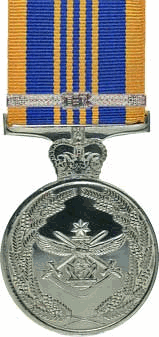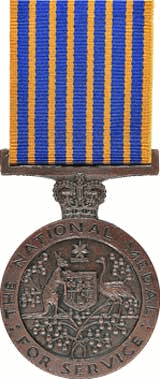The Australian honours and awards system refers to all orders, decorations, and medals, as instituted by letters patent from the Monarch of Australia and countersigned by the Australian prime minister at the time, that have been progressively introduced since 14 February 1975. The Australian honours and awards system excludes all state and local government, and private, issued awards and medals.
To be mentioned in dispatches describes a member of the armed forces whose name appears in an official report written by a superior officer and sent to the high command, in which their gallant or meritorious action in the face of the enemy is described.
The Conspicuous Service Cross (CSC) is a decoration (medal) of the Australian honours system. It is awarded to members of the Australian Defence Force "for outstanding devotion to duty or outstanding achievement in the application of exceptional skills, judgment or dedication, in non-warlike situations". In November 2019, 1129 people were listed as recipients. All ranks are eligible for the award.

The Meritorious Service Cross is a decoration that is, within the Canadian system of honours, one of the two Meritorious Service Decorations gifted by the Canadian monarch, his or her Governor-in-Council. Created in 1984, the medal is intended to recognize individuals—both Canadian and foreign—who have carried out meritorious acts bringing benefit and honour in either of two categories: military and civilian.
The Distinguished Service Cross (DSC) is a military decoration awarded to personnel of the Australian Defence Force. It is awarded for distinguished command and leadership in warlike operations. The DSC was introduced in 1991 and is the highest distinguished service decoration in the Australian Honours System. Recipients of the Distinguished Service Cross are entitled to use the post-nominal letters "DSC". Since its inception 115 awards have been made—which includes eight first bars and one second bar.
The Distinguished Service Medal (DSM) is a military decoration awarded to personnel of the Australian Defence Force for distinguished leadership in warlike operations. The DSM was introduced in 1991 and is the second highest distinguished service decoration in the Australian Honours System. Recipients of the Distinguished Service Medal are entitled to use the post-nominal letters "DSM". Since its inception 152 awards have been made—which includes six Bars—with the most recent being announced in the 2021 Queen's Birthday Honours.
The Commendation for Distinguished Service is a military decoration awarded to personnel of the Australian Defence Force, it is awarded for the distinguished performance of duties in warlike operations. The Commendation for Distinguished Service was introduced in 1991 and replaced its Imperial equivalent, Mention in Despatches. It is the third level of distinguished service decoration in the Australian Honours System.

The Star of Gallantry (SG) is a military decoration awarded to personnel of the Australian Defence Force (ADF) and other persons recognised by the Minister for Defence. It is awarded for acts of great heroism or conspicuous gallantry in action in circumstances of great peril. It is the second highest of the military gallantry awards in the Australian Honours System, only surpassed by the Victoria Cross or Victoria Cross for Australia (VC).
The Medal for Gallantry(MG) is a military decoration awarded to personnel of the Australian Defence Force. It recognises acts of gallantry in action in hazardous circumstances. The MG was introduced on 15 January 1991, replacing the Imperial equivalent. It is ranked third in the Gallantry Decorations in the Australian Honours System. Recipients of the Medal of Gallantry are entitled to use the post-nominal letters "MG".
The Governor-General of Australia publishes the order of wearing of Australian orders, decorations and medals in the Commonwealth of Australia Gazette. The Order of Wearing Australian Honours and Awards was last published in 2007.

The Reserve Force Decoration is an Australian Military award given for long service by officers of the Reserve Forces. It is part of the suite of defence force service awards introduced in 1982, which also included the Defence Force Service Medal and the Reserve Force Medal. However, the RFD is the only one of the three to carry a postnominal entitlement.
The Nursing Service Cross (NSC) is a conspicuous service decoration of the Australian honours and awards system, instituted by Letters Patent on 18 October 1989.

The Defence Force Service Medal (DFSM) is an Australian Military award given for long service by permanent members of the Australian Defence Force. It is part of the suite of defence force service awards introduced in 1982, which also included the Reserve Force Decoration and the Reserve Force Medal.

The Reserve Force Medal (RFM) is an Australian Military award given for long service by non-commissioned members of the Reserve Forces. It is part of the suite of defence force service awards introduced in 1982, which also included the Defence Force Service Medal and the Reserve Force Decoration.

The Defence Long Service Medal is an Australian military award given for long service by permanent and reserve members of the Australian Defence Force (ADF), irrespective of rank. It was introduced in 1998, and replaced the suite of ADF service awards introduced in 1982, which comprised the Defence Force Service Medal, the Reserve Force Medal and the Reserve Force Decoration.

The National Medal is an Australian award given for long service by operational members of specified eligible organisations. It was introduced in 1975, as an original component of the new Australian honours system, and replaced a range of medals available to military and civilian uniformed services for long service and good conduct. The eligible groups have in common that their members serve or protect the community at the risk of death, injury or trauma, hence it is only available to members of the eligible organisations who are operationally deployed. In the case of corrective services, eligibility is restricted to officers with custodial duties.

The Australian Cadet Forces Service Medal is awarded to recognise long and efficient service by officers and instructors in the Australian Defence Force Cadets. It is awarded for 15 years service. Additional clasps are issued for every 5 years additional service.

The Order of Military Merit is a military honour for merit that is, within the Canadian system of honours, the second highest order administered by the Governor in Council on behalf of the Canadian monarch.
The Order of Wearing of Australian honours includes Imperial honours if they were awarded prior to 6 October 1992. Imperial honours awarded after 5 October 1992 are considered foreign.
The Australian Intelligence Medal (AIM) is a civil decoration awarded to national intelligence community members for distinguished service. The decoration was introduced on 24 January 2020. Recipients of the Australian Intelligence Medal are entitled to use the post-nominal letters "AIM".









